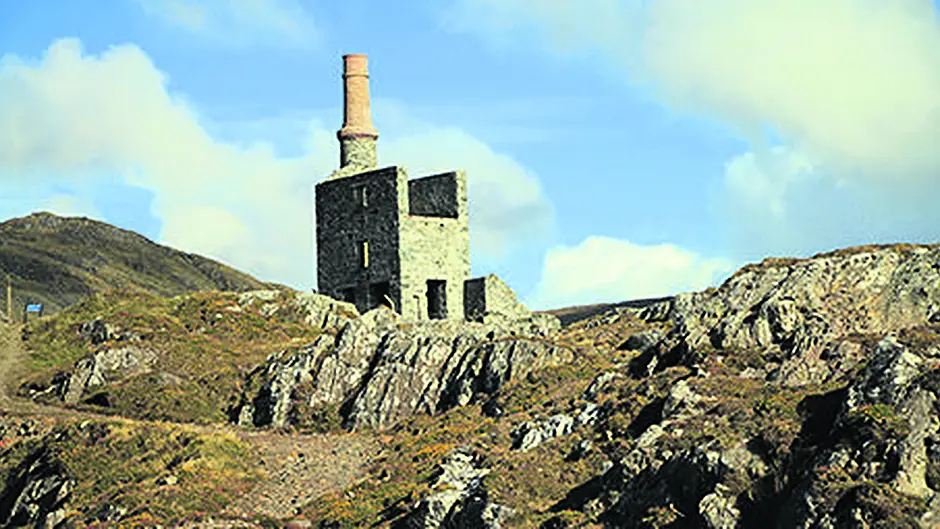In the aftermath of a giant sinkhole appearing recently in Allihies, HELEN RIDDELL looks back at the area’s rich mining history.
ONE of the most iconic features of the Allihies landscape is the ‘man-engine’ house of the former Allihies Copper Mines, which towers over the village.
Constructed in 1852 by the noted Cornish mining engineers, Michael Loam & Son, it was built to lower miners into the dark depths of the Allihies mines as they worked to bring copper ore to the surface.
Mining historian Theo Dahlke studied the Allihies Mines and its history for five years before he designed and built the exhibition in the award-winning Allihies Copper Mine Museum.
The museum was set up and run by the Allihies Parish Co-operatIve with massive financial support from shareholders and the community.
Dahlke curated the museum until he left in 2013 but he is still an active mining historian and involved in the recording and preservation of the Allihies mines.
There is evidence of mining in Allihies dating back to the Bronze Age, but modern mining, says Theo, began in 1812 when the local landlord John L Puxley formed the Allihies Mining Company, together with four fellow landowners. Initially, a small group of 27 miners began to mine the copper deposits at what would become Duneen Mine.
To reach the copper ore deposits, a shaft was sunk using hand drills and gunpowder. The miners would then blast horizontal tunnels trying to find the ore deposits. The broken ore was lifted and water was pumped out from the bottom of the shaft, which was getting deeper and deeper as new tunnels were driven into the copper vein.
When the mines finally closed, the mined-out cavities filled up with water and fell back into darkness not to be seen again. Today, the fenced-in openings or collars of the shafts are a common feature in the Allihies landscape.
There would eventually be five main mines in Allihies: Duneen Mine at the cliffs on the Urhan Road, Mountain Mine above the village (with Man Engine House), and Caminches Mine north west of the village (with its reservoir which, to this day, supplies the village with water), Coom Mine on the rocks east of the Village and Kealogue Mine in the middle of the valley with Puxley’s Engine House and the dressing floors, where the ore was processed.
Cornish miners were brought over to Allihies for their expertise in sinking shafts and for specific jobs. Local men worked the mine, while women and children were employed to sort the ore by hand before it was shipped to Swansea in Wales to be sold onto smelters. At its peak in 1835, the Allihies Mining Company employed 1,500 people and that year 7288 tons of copper ore were shipped to Swansea.
The dividends paid to the shareholders totalled £350, the highest ever payout. The reason so much is known about the Allihies mines is, Theo says, because John Puxley wrote regular updates to the main shareholder and landowner, Robert Hedges-Eyre of Macroom, and all this correspondence has survived.
The sinkhole, which appeared in recent weeks, is beside a shaft which is part of the Kealogue mine, the longest and deepest of the Allihies mines. Its deepest shafts go down to 442 metres. It was, says Theo, ‘a place of labour unrest, accidents and strikes.’
The mine records point out that the company had fierce problems keeping the Kealogue mine dry. They had to erect two pumping engines at both ends of the mine. The main problem today is that shafts were started in soft ground before they reached the underlying solid bedrock where the mining would have started. The top of those shafts would have been supported by a timber structure to keep the loose ground in place and the shaft open.
After 100 years or more, those timbers have now weakened. When John L Puxley died in December 1856, his son John Simon Lavallin Puxley took over the running of the mines, but died four years later in 1860, aged 29.
His brother Henry Lavallin Puxley inherited the mines, and would go on to spend £21,000 extending his mansion near Dunboy Castle. However, following the death of his young wife Katherine, he left Ireland before finishing the building.
By the late 1800s, a worldwide downturn in the price of copper saw profits in the Allihies mines severely decline and, when the Puxley family eventually sold the mine, the effect on the local area was devastating. However, the closure of the Allihies mines coincided with huge tracts of copper and silver being discovered in Butte, Montana, leading to large-scale emigration from Beara.
The skilled Beara miners were in high demand over in Butte, and over 1,200 men from Beara emigrated to Montana to mine what became known as ‘the richest hill on earth’. By 1900, a quarter of the Butte’s residents were Irish, and how important the Irish influence became in Butte is illustrated by the story of an Arab rug merchant named Mohammed Akara who changed his last name in court to Murphy which, he claimed, was for ‘business reasons’!









